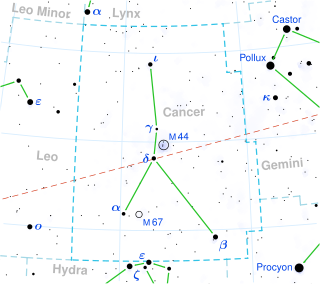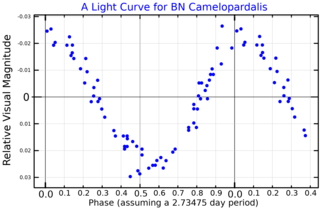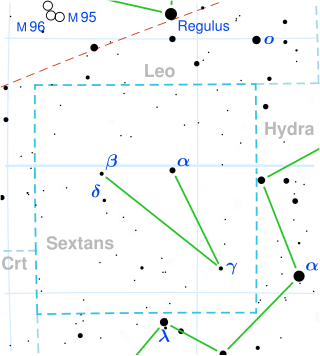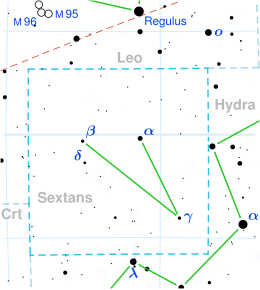
63 Andromedae is an Alpha2 Canum Venaticorum variable star in the constellation Andromeda. Its variable star designation is PZ Andromedae. With an apparent magnitude of about 5.6, it is bright enough to be seen by naked eye. Based upon an annual parallax shift of 8.53 mas, it is located 382 light years away.

21 Aquilae is a solitary variable star in the equatorial constellation of Aquila. It has the variable star designation V1288 Aql; 21 Aquilae is its Flamsteed designation. This object is visible to the naked eye as a dim, blue-white hued star with a baseline apparent visual magnitude of about 5.1. The star is located at a distance of around 680 light-years from Earth, give or take a 20 light-year margin of error. It is moving closer to the Earth with a heliocentric radial velocity of –5 km/s.

49 Cancri is a single star in the zodiac constellation of Cancer, located 501 light years away from the Sun. It has the Bayer designation b Cancri; 49 Cancri is the Flamsteed designation. It is visible to the naked eye as a faint star with an apparent visual magnitude of about 5.6. It is moving away from the Earth with a heliocentric radial velocity of +27.5 km/s.

HD 27245, also known as HR 1335 or rarely 25 H. Camelopardalis is a solitary red-hued star located in the northern circumpolar constellation Camelopardalis. It has an apparent magnitude of 5.4, making it faintly visible to the naked eye. Gaia DR3 Parallax measurements place it approximately 607 light years away from it the Solar System and is drifting further away with a heliocentric radial velocity of 25.2 km/s. At its current distance, HD 27245's brightness is diminished by 0.36 magnitudes due to extinction from interstellar dust. It has an absolute magnitude of −0.27.

BN Camelopardalis is a suspected astrometric binary in the northern circumpolar constellation of Camelopardalis. It appears as a variable star that is visible to the naked eye as a dim, white-hued point of light with an apparent visual magnitude that fluctuates around 5.49. The system is located at a distance of around 310 light years from the Sun based on parallax, and is drifting further away with a radial velocity of +9 km/s.

Eta2 Coronae Australis, Latinized from η2 Coronae Australis, is a solitary star located in the southern constellation of Corona Australis. It is visible to the naked eye as a dim, blue-white hued star with an apparent visual magnitude of 5.59. Gaia DR3 parallax measurements imply a distance of 770 light years from the Solar System, but it is drifting closer with a radial velocity of −23 km/s. At its current distance Eta2 CrA's brightness is diminished by 0.27 magnitudes due to stellar extinction from interstellar dust and it has an absolute magnitude of −0.24.

HR 273 is a chemically peculiar spectroscopic binary system in the northern circumpolar constellation of Cassiopeia. It has an apparent visual magnitude of 5.9 making it faintly visible to the naked eye from dark suburban skies. Parallax measurements with the Hipparcos spacecraft put this system at a distance of roughly 350 light years.
QV Andromedae is an Alpha2 Canum Venaticorum variable in the constellation Andromeda. Its maximum apparent visual magnitude is 6.6, so it can be seen by the naked eye under very favourable conditions. The brightness varies slightly following a periodic cycle of approximately 5.23 days.

Iota Mensae is a single star about 880 light years away in the faint constellation Mensa. It has a very slightly variable apparent magnitude of 6.0, making it visible with the naked eye under good skies.
HD 76270, also known as HR 3544, is a solitary, white hued star located in the southern circumpolar constellation Volans. It has an apparent magnitude of 6.10, making it faintly visible to the naked eye if viewed under ideal conditions. The object is relatively far with a distance of 2,360 light years, but is slowly approaching the Solar System with a heliocentric radial velocity of −2.6 km/s.

WZ Columbae, also known as HD 38170, is a solitary, bluish-white hued star located in the southern constellation Columba, the dove. It has an apparent magnitude of 5.28, allowing it to be faintly visible to the naked eye. Based on parallax measurements from the Gaia spacecraft, the object is about 365 light years distant. It appears to be receding from the Solar System, having a heliocentric radial velocity of 36.3 km/s.

CW Octantis, also known as HD 148542, is a solitary, white hued variable star located in the southern circumpolar constellation Octans. It has an apparent magnitude of 6.03, allowing it to be faintly visible to the naked eye. Parallax measurements from Gaia DR3 place the object at a distance of 629 light years. It appears to be receding from the Solar System with a heliocentric radial velocity of 7.1 km/s.

PW Telescopii, also known as HD 183806 or simply PW Tel, is a solitary variable star located in the southern constellation Telescopium. It has an average apparent magnitude of 5.58, making it faintly visible to the naked eye. Based on parallax measurements from the Gaia satellite, the star is estimated to be 395 light years distant. It appears to be approaching the Solar System with a heliocentric radial velocity of −10 km/s. The value is somewhat constrained, having an uncertainty of 26%. At its current distance, PW Tel's brightness is diminished by 0.05 magnitudes due to interstellar dust.

HD 31134, also designated as HR 1561, is a solitary star located in the northern circumpolar constellation Camelopardalis, the giraffe. It is faintly visible to the naked eye as a white-hued star with an apparent magnitude of 5.74. Gaia DR3 parallax measurements place it 473 light years away. It appears to be approaching the Solar System with a heliocentric radial velocity of −15.1 km/s. At its current distance, HD 31134's brightness is diminished by 0.35 magnitudes due to interstellar dust. It has an absolute magnitude of +0.19.

V686 Coronae Australis is a solitary, bluish-white-hued variable star located in the southern constellation Corona Australis. It has an apparent magnitude that ranges between 5.25 and 5.41, which makes it faintly visible to the naked eye. Gaia DR3 parallax measurements imply a distance of 480 light years and it is slowly receding with a heliocentric radial velocity of 1.3 km/s. At its current distance V686 CrA's average brightness is diminished by 0.35 magnitudes due to extinction from interstellar dust and it has an absolute visual magnitude of −0.24.

QQ Telescopii, also known as HD 185139 or simply QQ Tel, is a solitary variable star located in the southern constellation Telescopium. It has an apparent magnitude of 6.25, placing it near the limit for naked eye visibility, even under ideal conditions. Gaia DR3 parallax measurements imply a distance of 333 light years and it is currently receding with a heliocentric radial velocity of 7.8 km/s. At its current distance, QQ Telescopii's brightness is diminished by two tenths of a magnitude due to interstellar dust and it has an absolute magnitude of +1.01.

V692 Coronae Australis, or simply V692 CrA, is a whitish-blue hued variable star located in the southern constellation Corona Australis. It has a maximum apparent magnitude of 5.46, making it faintly visible to the naked eye. The object is located relatively far at a distance of approximately 1,900 light years based on Gaia DR3 parallax measurements, but it is approaching the Solar System with a fairly constrained heliocentric radial velocity of −15.3 km/s. At its current distance, V692 CrA's brightness is heavily diminished by 0.46 magnitudes due to extinction due to interstellar dust. Its absolute magnitude depends on the source: Westin (1985) gave a value of −6.44 while the extended Hipparcos catalogue gave a value of −2.26.

HD 194783 is a solitary star located in the southern constellation Microscopium near the border with Sagittarius. It is barely visible to the naked eye as a bluish-white-hued point of light with an apparent magnitude of 6.08. The object is located relatively far at a distance of 740 light-years based on Gaia DR3 parallax measurements, but it is drifting closer with a heliocentric radial velocity of −9.7 km/s. At its current distance, HD 194783's brightness is diminished by an interstellar extinction of 0.31 magnitudes and it has an absolute magnitude of either −0.59 or −1.10, depending on the source.

18 Sextantis, or simply 18 Sex, is a solitary star located in the southern constellation Sextans. It is faintly visible to the naked eye as an orange-hued point of light with an apparent magnitude of 5.62. Gaia DR3 parallax measurements imply a distance of 558 light-years and it is slowly receding with a poorly constrained heliocentric radial velocity of approximately 0.2 km/s. At its current distance, 18 Sex's brightness is diminished with an interstellar extinction of two-tenths of a magnitude and it has an absolute magnitude of −0.16.

35 Sextantis, or simply 35 Sex, is a triple star system located in the equatorial constellation Sextans. The primary has an apparent magnitude of 6.09, making it barely visible to the naked eye, even under ideal conditions. The companion has an apparent magnitude of 7.01, making it readily visible in binoculars, but not to the naked eye. The system is located relatively far at a distance of approximately 700 light-years but it is drifting closer with a combined heliocentric radial velocity of −2.18 km/s.














